Please Fasten Your Seat Belts
How crash tests, mangled cars and grieving families drove Singapore’s battle to protect motorists’ lives.
By Sharon Teng
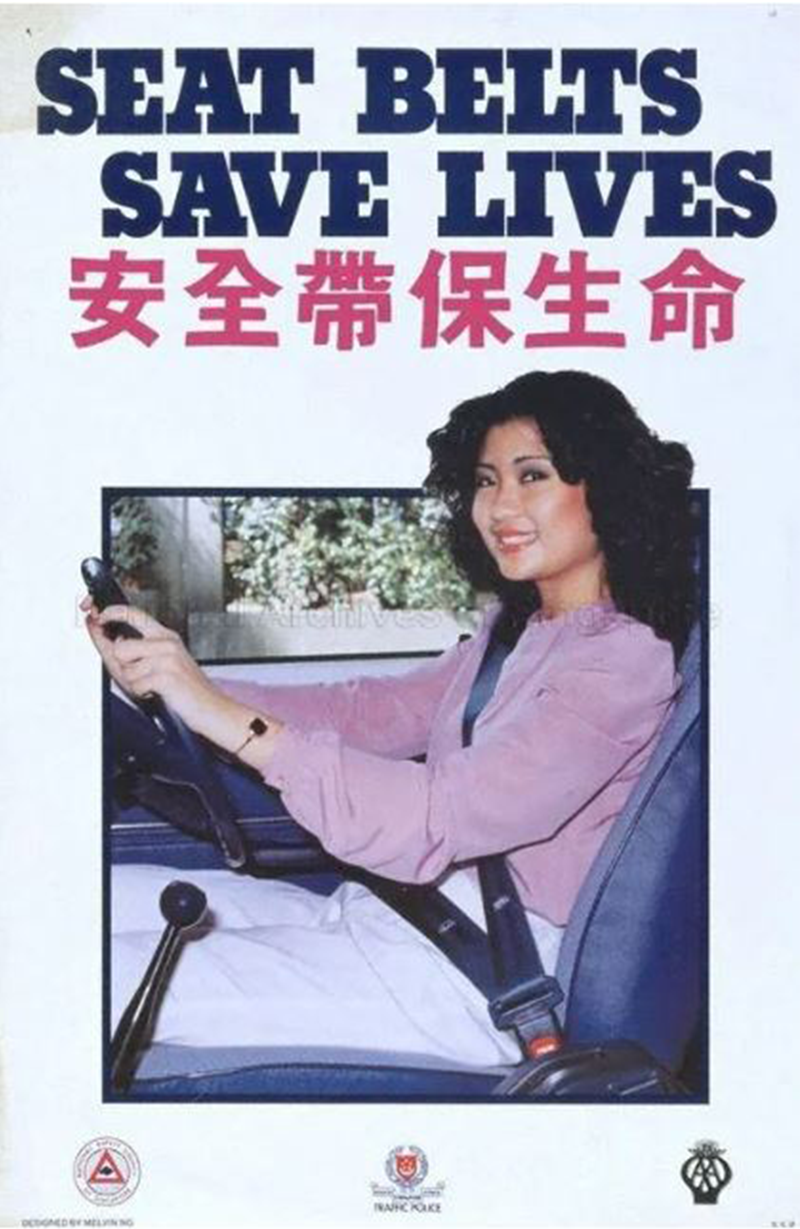
Most race car drivers attempt to avoid collisions. On 4 June 1977, however, race car driver Nick van Nugteren decided to deliberately crash into a stationary vehicle while driving at 52 kph. Fortunately, van Nugteren emerged unscathed, though the same cannot be said for the passenger in the front seat, a human-size scarecrow with a watermelon for a head. The impact threw the “passenger” against the dashboard and his watermelon head split into two.
The reason that the outcome for van Nugteren was so different was that while van Nugteren was wearing a seat belt, his passenger was not. “I could feel the belt tugging me backwards. Had it not been for it, I would not have been so lucky to have escaped unhurt,” said van Nugteren.1
“I have been racing for 11 years and have been involved in enough accidents to know the value of seat belts. There is a tendency among drivers to panic and lose control in an accident. Having a seat belt on in such circumstances, can not only prevent unnecessary injuries but save one’s life as well,” he added.2
The reason for this unorthodox stunt was to persuade a dubious public in Singapore to don seat belts, which was particularly necessary because there was no legal requirement to wear a seat belt while in a car at the time. It was only in 1983 that it became mandatory for people in the front seat of cars to belt up, while the rule that passengers in the back had to do so came into existence nine years later.
Making Front Seat Belts Mandatory
Seat belts themselves are a relatively recent phenomenon. Prior to the 1950s, seat belts were not a standard feature in motor cars. The modern seat belt was patented in 1955 and major manufacturers began installing them as standard equipment from the late 1950s. To increase the survival rate of motorists during accidents, the Automobile Association of Singapore recommended in 1963 that new cars be fitted with front-seat “safety harnesses”. In 1967, the National Safety First Council of Singapore also pushed for all motorists to wear safety seat belts.3
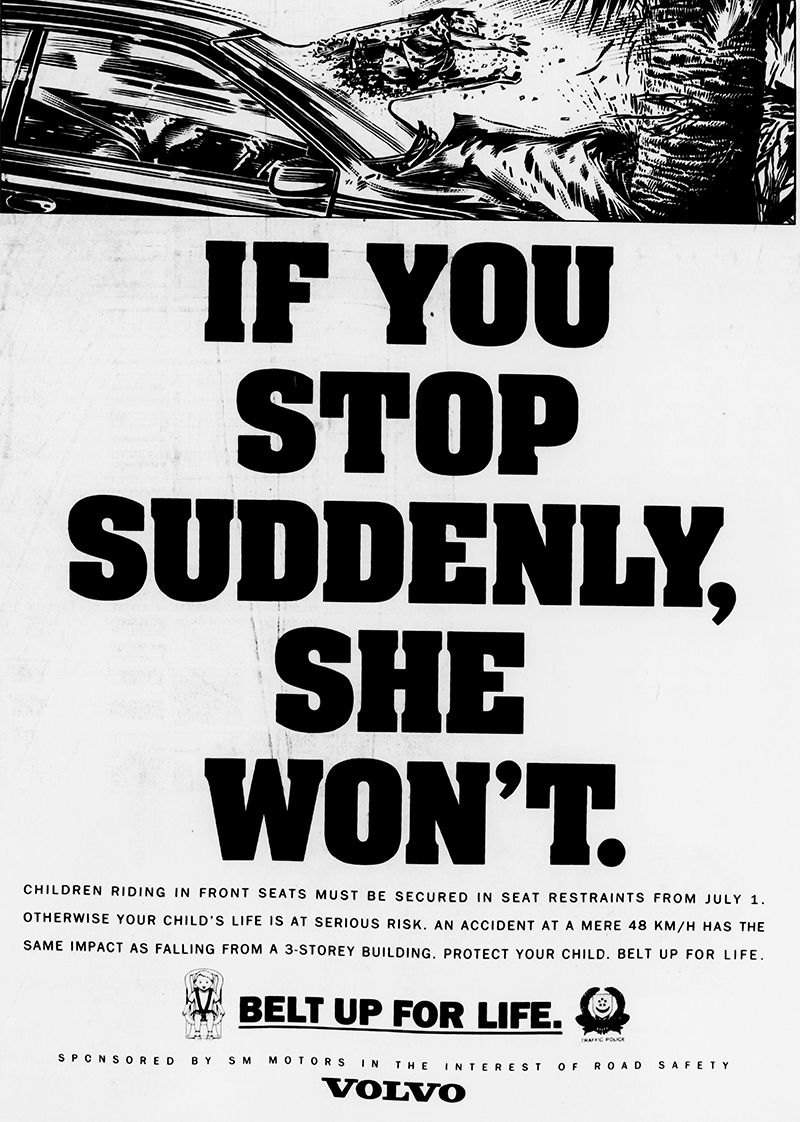
It would take more than 10 years after that before the government stepped in. In September 1977, the government announced that from 1 January 1978, all new cars and station wagons registered on or after this date would be installed with front seat belts: the three-point lap-shoulder version found to be the most effective in restraining the upper and lower parts of the body. The use of front seat belts was made mandatory from 1 January 1983. Exemptions, however, were granted on medical or psychological grounds for those with physical abnormalities, the elderly, people with disabilities and pregnant women.4
Speaking at a May 1977 press conference on the use of seat belts, Senior Minister of State for Communications Ong Teng Cheong declared that seat belts were indispensable to reduce the incidence of death and severity of injuries in car accidents. “Proper use of seat belts prevents a driver and his front seat passenger from flying through the windscreen or from being thrown against the steering wheel and dashboard, and from being hurled through open doors in an accident,” he said.5
At the time, only around 20 percent of cars and vans in Singapore were fitted with seat belts, and only between 2 and 5 percent of drivers and passengers actually used them.6 To educate the public, the government launched the inaugural National Seat Belt Campaign from 10 September 1977 to 18 January 1978. As part of the campaign, a week-long Seat Belt Exhibition displaying various models of government-endorsed seat belts was concurrently held at the Victoria Memorial Hall.7
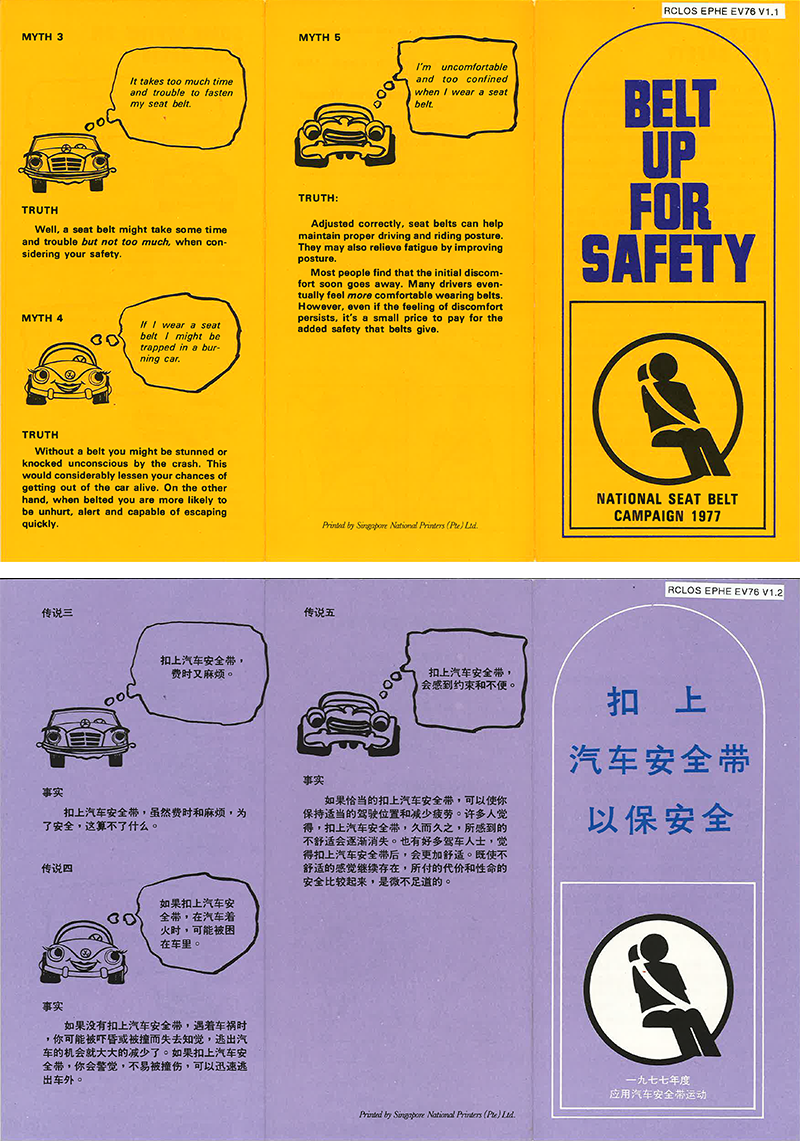
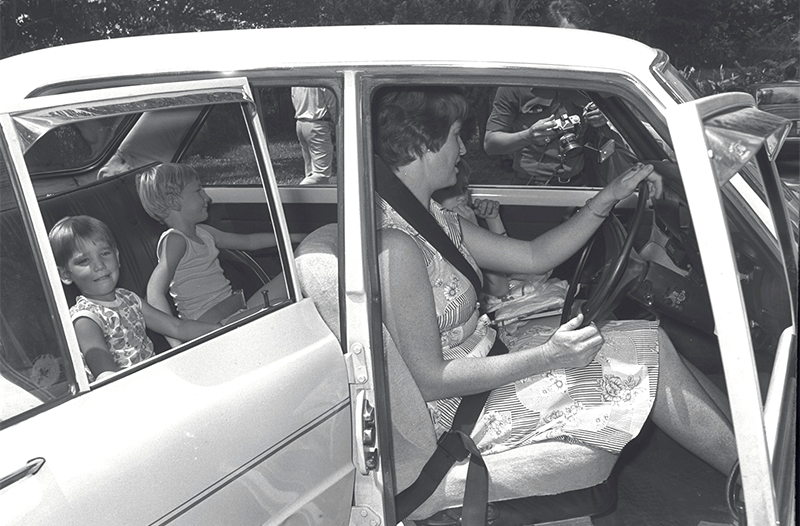
Naturally, people resisted changing their behaviour. Motorists considered seat belts “inconvenient”, “troublesome”, an “infringement of personal freedom”, “sissy” and even a potential “death trap”. Some also believed that it was “safer to be thrown out” of a vehicle during an accident.8
Then there were others who argued that Singapore was too small and driving distances too short to be worth the effort. “I assume everyone knows the risks involved in not wanting to strap on a belt, but then in Singapore, where the travelling distances are generally short, I suppose motorists find it too much of a bother to use a safety belt,” motorist Henry Soh told the Straits Times in July 1976. Another motorist, Benny Ang, claimed that “without a belt, [the driver] can perhaps crawl out of his car and if he is thrown out by the impact of the crash he may stand a better chance of surviving”.9
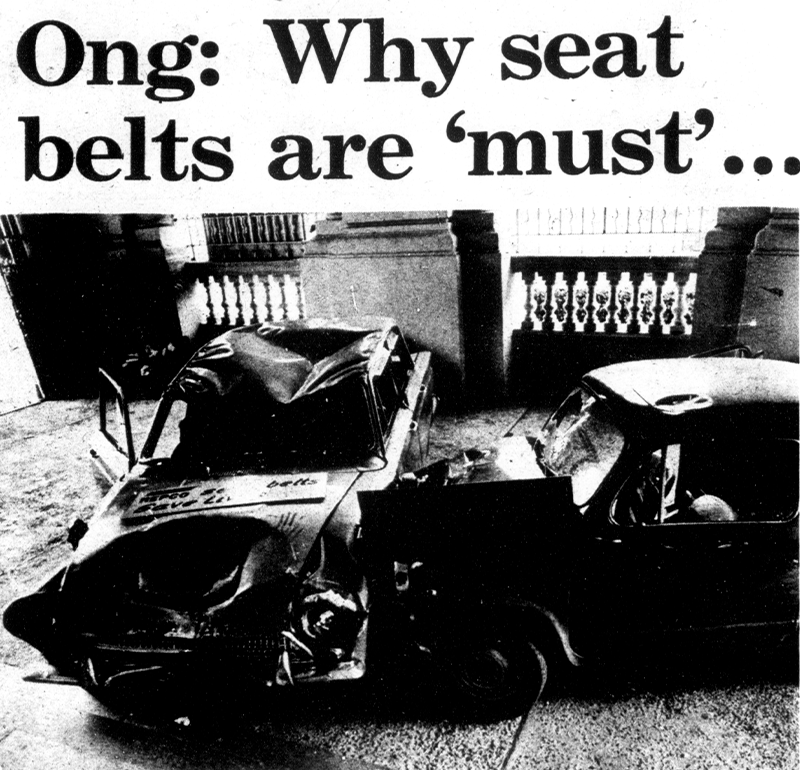
Rear Seat Belts Became Mandatory
While front seat belts became mandatory in 1983, it would take another nine years for similar regulations to apply to the back seat. From 1 October 1992, rear seat passengers were required to belt up and passengers above 16 years and drivers who failed to comply would be fined $120, with drivers receiving an additional three demerit points. Additionally, cars registered on or after 1 January 1993 were required to have rear seat belts installed.10
The risk of fatal injuries and the penalty of a $120 fine did little to change motorists’ habits though. Between 1993 and 1994, 540 summons each year were issued to back-seat passengers who did not use seat belts.11
When interviewed by the Straits Times in May 1996, Alen Lee, a 31-year-old administrator, said of his rear seat passengers: “When the rule was implemented, I kept telling them to put on the seat belts. But they refused to, saying it was uncomfortable. After a while, I gave up asking.” Yeo Teng Seng, a 42-year-old taxi driver, echoed this helplessness: “I would advise them to put on their seat belts, but some ignore me. I cannot force them. If traffic police stops us, then got problem.”12
The fine was increased to $150 in 2019 to ensure that the heavier penalty acted as a deterrence to breaking the law. If charged in court, offenders could be fined up to $1,000 or jailed for three months.13
Seat Belt Rule for Children in Cars
In addition to getting adults to use seat belts, there was also the related problem of getting kids to belt-up. The issue for children is complicated by the fact that young children, especially, do not like being restrained, and that normal seat belts are designed for adult proportions.
A Straits Times survey in 1990 revealed that while many parents recognised the importance of restraining their children in a moving vehicle, few practised this as it was not mandated by law. Many believed that it was sufficient for young children to use seat belts designed for adults. Some parents even felt that children should be given freedom to move around, while others believed that front seats would act as a sufficient barrier during crashes.14
Sometimes, parents would be belted up while their children simply sat on their laps. This, however, is quite unsafe. “The child being held in the front seat becomes a cushion in case of an accident and the child in the back seat could be thrown out like a missile with the force of an accident,” said Professor Chao Tzee Cheng, vice-president of the National Safety Council and medical director of Forensic Medicine at Singapore General Hospital.15
These attitudes persisted despite cases of children getting injured or killed in accidents because they were unrestrained. The Straits Times reported that in June 1990, a five-year-old boy in the front seat on his father’s lap was thrown out of the van when it swerved and skidded to avoid hitting a pedestrian. The boy was the only casualty among the 11 passengers in the van.16
To increase public awareness of the use of child restraints, the government launched the “Belt Up for Life” campaign in May 1992. A commercial was also aired on television showing a mother and a child in her lap being thrown through their car windscreen when the vehicle jerked to a stop.17
On 1 July 1992, the seat belt rule for children was implemented in Singapore, requiring children under eight to be belted up or harnessed when seated in the front of motor vehicles. Children below 1.5 m had to use child safety belts, while taller ones should use the installed seat belts. From 1 October 1992, children in the back seats of cars were also covered by this rule.18
Having new traffic rules was one thing. Getting parents to belt up their kids was something else altogether. Zainaba Mohamed, managing director of a travel company, confessed to the Straits Times in May 1995: “When I’m going to the provision shop nearby, I don’t put my children in their child seats. It’s just a short journey, they’ll feel uncomfortable.” Wong Ah See, a tutor, added: “My boy cries when I put him in the child seat. He hates it. He wants to look out of the window. I try to force him, but sometimes I cannot be bothered to do so.” It would sometimes take an accident to persuade parents to change their thinking. “[A] taxi cut into my lane and I had to jam on my brakes. My son, in the front seat, banged his head on the dashboard,” said housewife Ellice Ng. Her son ended up with a bruised forehead but that was enough to scare her into buying a child seat.19
On 1 January 2012, the seat belt requirements for children were revised with the age criterion replaced with a height requirement. Children shorter than 1.35 m were required to use age-appropriate child restraints, booster seats or adjustable seat belts, while those 1.35 m and above, irrespective of age, had to wear seat belts. 20
Taxis were exempted from the new regulations as street-hailing made it impractical for them to be equipped with various child seat configurations at all times. But anyone below 1.35 m would not be allowed to sit in the front passenger seat of taxis unless the person used a child restraint or booster seat to supplement the seat belt.21
Seat Belts for School Buses
The issue of whether buses ferrying schoolchildren should be equipped with a seat belt for every seat was first raised in Parliament in 2006 by Nominated Member of Parliament Ong Soh Khim. Minister for Transport Yeo Cheow Tong said that the Land Transport Authority (LTA) would consult the Traffic Police and stakeholders, and review passenger-control measures, accident trends and statistics, as well as the cost impact on parents.22
The unfortunate death of eight-year-old Russell Koh, who was flung out from the rear door of a minibus after it was hit by two cars on 24 April 2008, reignited calls from parents for minibuses to be installed with seat belts.23
The Singapore School Transport Association, however, argued that installing seat belts would reduce passenger capacity and significantly cut drivers’ income, while school bus operators said that they would have no choice but to increase fares. Although some schools insisted that school buses be equipped with seat belts, others believed that bus assistants could be relied on to ensure that the children remain seated.24
Parents were also divided. While some parents were adamant about making seat belts compulsory for school buses, others were disinclined to continue with the school bus service if fares were to increase. Lye Bee Lian, a homemaker who was paying $120 a month for her two primary school-going sons on a school bus, said she may let them take public transport instead. “The price of everything has gone up. If I have to pay another $60 a month, I might just have to find a cheaper alternative,” she said.25
In 2008, Senior Minister of State for Transport Lim Hwee Hua announced in Parliament that the LTA would mandate seat belts in all new small buses (with a capacity of 15 passengers or fewer). School buses had to be retrofitted with retractable three-point seat belts by 2011 while smaller buses had until 2013.26
The Situation Today
Today, four decades after they were first made mandatory, the problem with getting people to use seat belts still exists. Statistics from the Traffic Police revealed that in 2023, there were 3,559 violations for failing to wear either front or rear seat belts. The good news is that this was a drop from 5,863 in 2021. However, although the number of violations has dipped, there has been an increase in the number of severely injured unbelted passengers admitted to the National University Hospital, Tan Tock Seng Hospital and Khoo Teck Puat Hospital between 2022 (20 patients) and 2023 (25 patients).27
In recent years, the rise of private hire services had brought new challenges, particularly with parents attempting to travel with young children. Private hire drivers frequently encountered parents with young children trying to board without the required booster seats. In response, ride hailing operators Grab and Gojek have advised drivers to decline such bookings, directing customers instead to child-friendly services like GrabFamily which provide appropriate seats for young children, or GoCar Kids and GoCar XL Kids offered by Gojek.28
When journalist Steve Chia went undercover with the Traffic Police during a Talking Point episode in July 2024, an interview with two private hire drivers revealed that only around 40 percent of passengers took the initiative to wear rear seat belts and some would be unhappy if asked to do so. Passengers sitting in the back middle seat were also shown in studies to be the least compliant when wearing seat belts, making it the most dangerous place to be in the vehicle when unbelted.29
In a letter to the Straits Times in May 2025, private-hire driver Wilbert Wong shared that child passengers who are two or three years old did not like to be restrained by seat belts. “The adults often have to hold the child to keep him quiet. Though I am aware of the law for children to be properly belted up, I have no choice but to drive more slowly and safely, and stay alert to avoid the risk of accidents,” he said. 30
In another letter, Cyril Seah Chen Chuan said: “I often see children in private cars (especially) sitting on adults’ laps, either in the back or worse, in the front passenger seat, or standing between the two front seats or sitting and kneeling in the back seat without being safely secured.” He urged the authorities to take sterner action against law breakers and “punish adults who put children at risk, knowingly or otherwise”.31
By now, the jury is in on the necessity of wearing a seat belt. “The chances of an unbelted patient getting to a hospital alive after a bad crash is close to zero,” said Teo Li-Tserng, director of the Tan Tock Seng Hospital Trauma Centre and regional director of the Central Region Trauma Services under the National Healthcare Group. “Those who wear a seat belt may still get injured, but their injuries are usually not as immediately life-threatening,” he added. “This gives them time to be transported to a hospital where they can be treated”.32
Anecdotally, most drivers and front seat passengers these days will have their seat belts on. The same, however, cannot be said for passengers in the back. Rear seat belt reminder systems, which detect unbuckled rear seats and provide visual and audible alerts to the driver, are currently not required under the older internationally recognised standards. However, the LTA is considering making rear seat belt reminders mandatory for all seats in new cars, taking into account the lead time needed for car manufacturers to implement the changes.33
 Sharon Teng is a Senior Librarian with the National Library Singapore. She is part of the Arts and General Reference team, and manages the Social Sciences and Humanities Collection.
Sharon Teng is a Senior Librarian with the National Library Singapore. She is part of the Arts and General Reference team, and manages the Social Sciences and Humanities Collection.Notes
-
“Racing Enthusiast’s Message: Belt Up If You Value Life,” Straits Times, 5 June 1977, 5; Nick van Nugteren, “Safety Belt Saved Me from Pain…,” New Nation, 10 June 1977, 12. (From NewspaperSG) ↩
-
“Racing Enthusiast’s Message: Belt Up If You Value Life”; “Safety Belt Saved Me from Pain….” ↩
-
In countries where the wearing of seat belts is compulsory, statistics show higher survival rates when seat belts are worn. The use of seat belts in West Germany, for example, resulted in a 50 percent drop in traffic accident fatalities. Verity Gill, “Strap Yourself in for Safety,” Straits Times, 30 August 1963, 7; “Council’s Plea to Motorists: Use Safety Seat Belts,” Eastern Sun, 12 July 1967, 10; “Safety Belts,” Straits Times, 12 July 1967, 11; “Belt Up and Live! An Excellent Motto for Drivers,” New Nation, 27 October 1971, 18; “Don’t Wait – Belt Up Today,” New Nation, 20 May 1977, 8. (From NewspaperSG) ↩
-
Gloria Chandy, “Belt Up!,” New Nation, 9 September 1977, 9; “Ong: Why Seat Belts Are ‘Must’…,” New Nation, 10 September 1977, 2. (From NewspaperSG) ↩
-
Ong Teng Cheong, “Press Conference on the Use of Seat Belts,” speech, PSA Conference Room, 21 May 1977, transcript, Ministry of Culture. (From National Archives of Singapore document no. otc19770521s) ↩
-
Ong, “Press Conference on the Use of Seat Belts”; “Road Deaths Can Be Halved by Belting Up,” Straits Times, 12 September 1977, 8; Lloyd Timberlake, “Use of Car Seat Belts Halves Fatal Injuries, According to Survey,” Straits Times, 14 July 1978, 35. (From NewspaperSG) ↩
-
Gloria Chandy, “Belt Up!,” New Nation, 9 September 1977, 9; “Ong: Why Seat Belts Are ‘Must’…,” New Nation, 10 September 1977, 2; Bailyne Sung, “4-Stage Plan for Seat Belts,” Straits Times, 11 September 1977, 1; “Seat Belt Campaign Goes to the Schools,” Straits Times, 7 October 1977, 17; Problem of Getting Drivers to Belt Up,” Business Times, 15 November 1977, 9; “Campaign Ends,” Straits Times, 18 January 1978, 13. (From NewspaperSG) ↩
-
“Seat Belts,” Straits Times, 22 July 1976, 9. (From NewspaperSG); Lee, “Another Plea for Safety Belts”; “Racing Enthusiast’s Message: Belt Up if You Value Life”; Chandy, “Belt Up! ↩
-
“Seat Belts.” ↩
-
“Rear Seatbelt Rules Apply to Adults Too from October”; “Reminder Campaign on Rear Seat Belt Law,” Straits Times, 25 September 1992, 25. (From NewspaperSG) ↩
-
Ginnie Teo and Leong Chan Teik, “Many Rear-Seat Passengers Ignore Traffic Rule to Belt Up,” Straits Times, 5 May 1996, 25. (From NewspaperSG) ↩
-
Teo and Leong, “Many Rear-Seat Passengers Ignore Traffic Rule to Belt Up.” ↩
-
Ministry of Home Affairs, “Strengthening Deterrence Against Irresponsible Driving,” press release, 21 February 2019, https://www.mha.gov.sg/mediaroom/press-releases/strengthening-deterrence-against-irresponsible-driving/. ↩
-
As the musculoskeletal structures of young children are not yet fully developed, experts advised that approved child restraints or seats be used instead of seat belts. In a car crash, child safety restraints reduce the forces on the child by distributing them to the strongest parts of the body (hips, back and shoulders). They also serve as protection against hard surfaces inside the car. Rav Dhaliwal, “Don’t Put Your Child at Risk in the Car,” Straits Times, 21 March 1990, 25; “Why Most Parents Don’t Strap Children to Car Seats,” Straits Times, 18 April 1991, 24; “Buckle Up the Kids,” Straits Times, 5 September 2009, 118. (From NewspaperSG) ↩
-
Dhaliwal, “Don’t Put Your Child at Risk in the Car.” ↩
-
Syed Jaffar, “Strap Your Child for Life,” Straits Times, 21 April 1992, 6. (From NewspaperSG). Studies also showed that injuries fell substantially when children were belted up. In the United States, child seat safety laws led to a 30 percent decrease in infant deaths, and restraints effectively reduced fatalities and injuries by 70 percent. Findings from a German study of 870 accidents revealed that it was three times more likely for an unrestrained child to suffer serious injuries and seven times more likely to be fatally injured. ↩
-
Chooi Tow Kwan, “Ad Drives Home Child Safety,” New Paper, 21 May 1992, 11. (From NewspaperSG) ↩
-
M. Nirmala, “Rules on Seat Belts for Children to Start on July 1,” Straits Times, 22 March 1992, 1. (From NewspaperSG) ↩
-
“Why Most Parents Don’t Strap Children to Car Seats”; Ginnie Teo, “Belting Up Kids a Hassle for Parents,” Straits Times, 5 May 1995, 30. (From NewspaperSG) ↩
-
Nirmala, “Rules on Seat Belts for Children to Start on July 1.” ↩
-
Shuli Sudderuddin, “Stricter Seat-Belt Rules for Small School Buses”; Jane Ng, “What a Squeeze,” Straits Times, 15 January 2012, 10. (From NewspaperSG); “Point-to-Point Services Balance Safety and Practicality for Families With Young Children,” Land Transport Authority, accessed 14 May 2025, https://www.lta.gov.sg/content/ltagov/en/newsroom/2024/12/media-replies/point-to-point-services-balance-safety-and-practicality-for-fami.html. ↩
-
Parliament of Singapore, Tenth Parliament, vol. 81 of Parliamentary Debates: Official Report, 28 February 2006, cols. 313–15. (From National Library Singapore, call no. RSING 328.5957 SIN) ↩
-
Teh Joo Lin and Diana Othman, “Parents Want Children Buckled Up in Minibuses,” Straits Times, 30 April 2008, 31. (From NewspaperSG) ↩
-
Teh and Diana Othman, Parents Want Children Buckled Up in Minibuses”; Tan Dawn Wei and Jamie Ee Wen Wei, “Strapping in the Students: The Costs and Concerns,” Straits Times, 11 May 2008, 12. (From NewspaperSG) ↩
-
Teh and Diana Othman, “Parents Want Children Buckled Up in Minibuses”; Tan and Ee, “Strapping in the Students: The Costs and Concerns.” ↩
-
Parliament of Singapore, Eleventh Parliament, vol. 84 of Parliamentary Debates: Official Report, 26 May 2008, cols. 2753–761 (From National Library, Singapore, call no. RSING 328.5957 SIN); Parliament of Singapore, Eleventh Parliament, vol. 85 of Parliamentary Debates: Official Report, 17 November 2008, cols. 722–23 (From National Library Singapore, call no. RSING 328.5957 SIN); Shuli Sudderuddin, “Stricter Seat-Belt Rules for Small School Buses.” ↩
-
Shiying Wong, “She Didn’t Wear Her Seat Belt and Lost Her Memory After Crash,” Straits Times, 8 September 2024. (From Newslink via NLB’s eResources website) ↩
-
Toh Ting Wei, “Many Parents Not Using Car Child Restraints While Travelling with Children in Cars: Survey,” Straits Times, 3 March 2019. (From Newslink via NLB’s eResources website); “GoCar Kids: For Families With Young Children,” Gojek, 7 November 2024, https://www.gojek.com/sg/blog/dp-gocar-kids. ↩
-
CNA Insider, “Seatbelts in the Backseat: Why Aren’t We Wearing Them?” Talking Point, 15 July 2024. YouTube video, 6:27–7:25, 13:33–14:09. https://youtu.be/VghXT2SEPe8?si=6P. ↩
-
Wilbert Wong, “Hard to Keep Hyperactive Kids Belted Up,” Straits Times, 3 May 2025. (From Newslink via NLB’s eResources website) ↩
-
Wong, “Hard to Keep Hyperactive Kids Belted Up.” ↩
-
Wong, “She Didn’t Wear Her Seat Belt and Lost Her Memory After Crash.” ↩
-
CNA Insider, “Seatbelts in the Backseat: Why Aren’t We Wearing Them?”, 17:03–18:35. ↩

